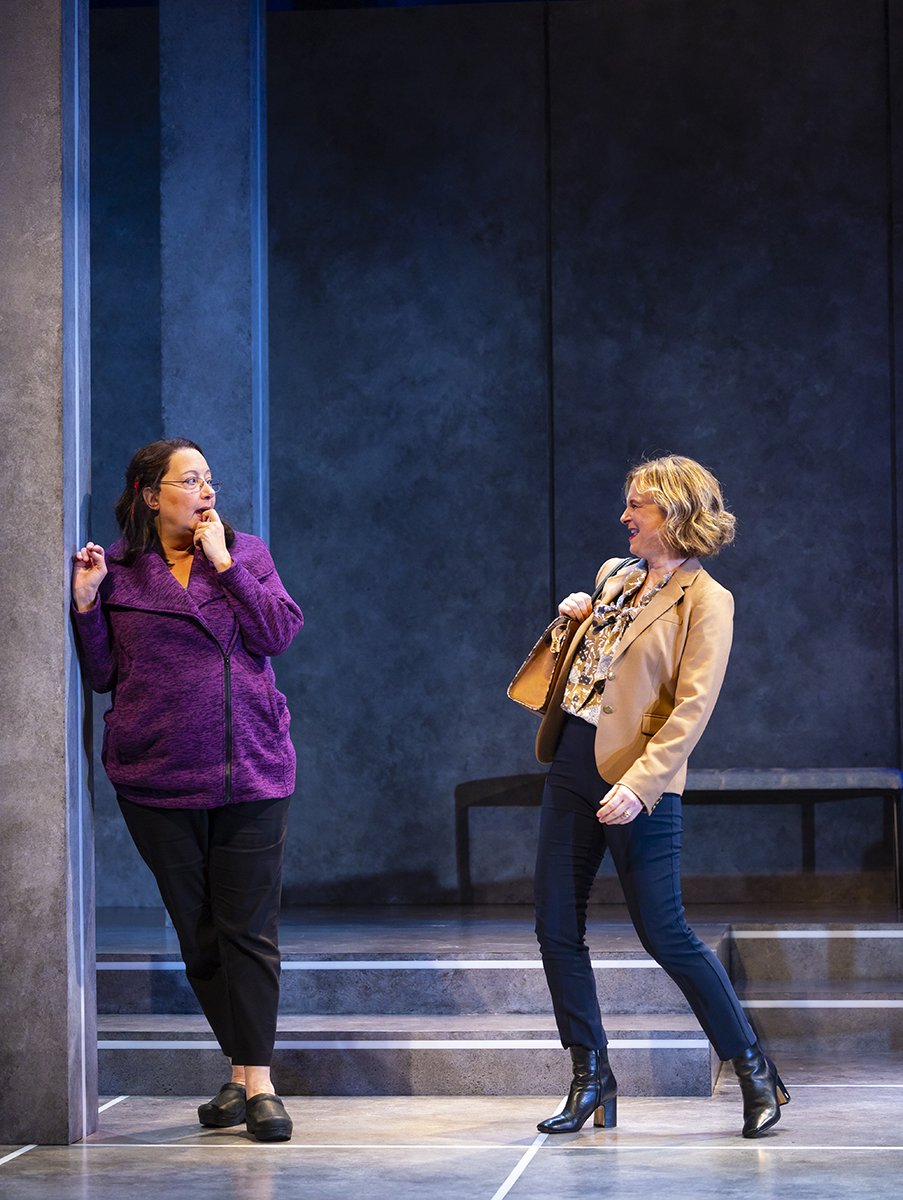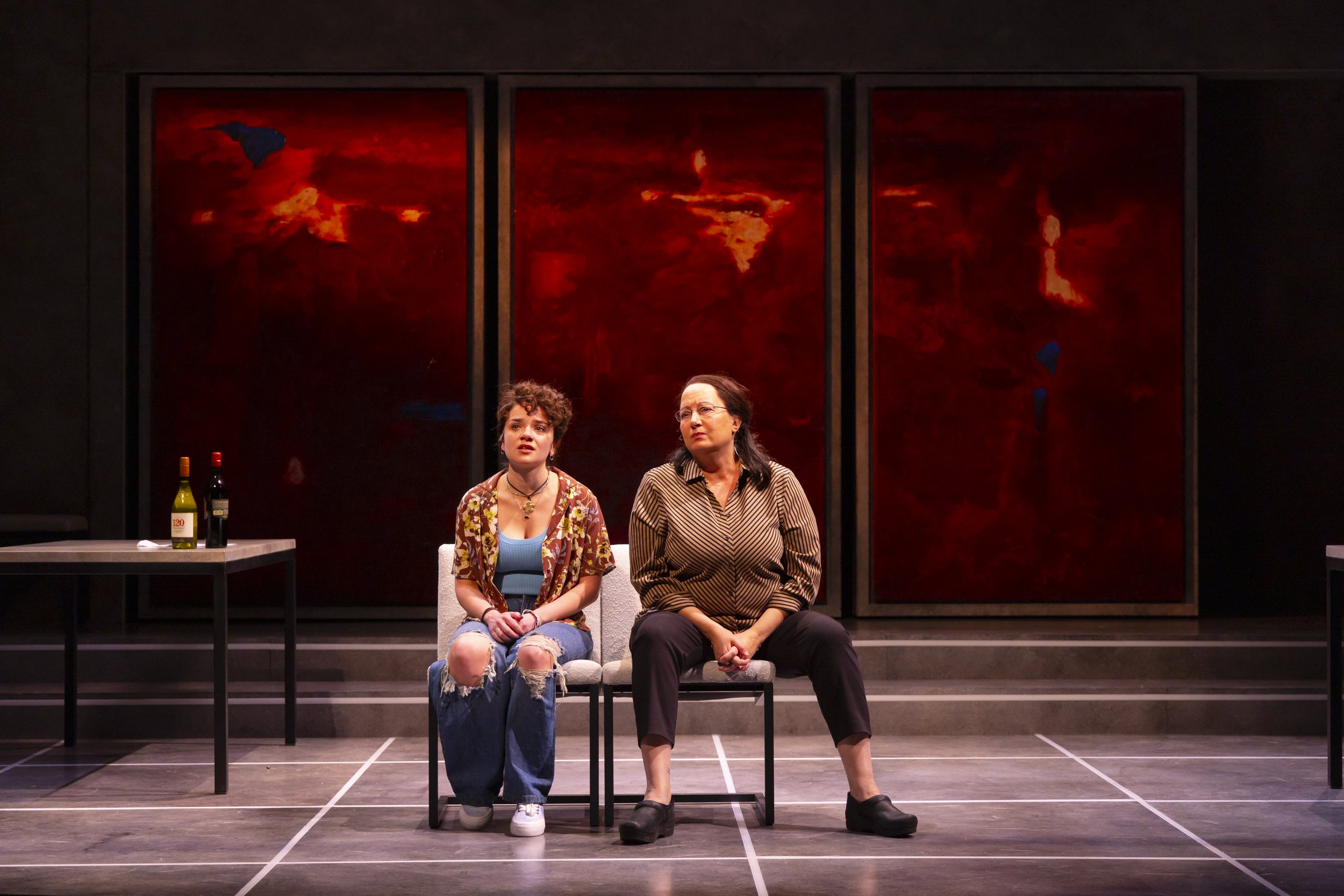Review of The Art of Burning, Hartford Stage
Now continuing its world premiere after a run in Boston, directed by Hartford Stage Artistic Director Melia Bensussen, Kate Snodgrass’s The Art of Burning mines both the comedy and the drama of unsuccessful marriages, while giving a refreshing emphasis to a teenage daughter caught in the crossfire. Along the way the play explores what constitutes stability and sustainability—not only in relationships but in our inter-relations with others as a measure of how we choose to live in the world. At the heart of the play is the fraught question of how parents manage their priorities in life while beginning to see what’s owed the next generation.
Patricia (Adrianne Krstansky), Mark (Michael Kaye), Jason (Rom Barkhordar) in Kate Snodgrass’s The Art of Burning at Hartford Stage, directed by Melia Bensussen (photo by T. Charles Erickson)
Poised on the New Brutalist stylings of Luciana Stecconi’s set of hard surfaces and sharp corners, with an effective lighting grid in the floor to signal scene shifts, the play opens with Patricia (Adrianne Krstansky), an artist and mother, in prickly colloquy with Mark (Michael Kaye), a friend and attorney placed in the position of mediating her divorce from his friend Jason (Rom Barkhordar). Such a setup would generally bespeak a friendly dissolution of the marriage, and such may have once been expected, but things have taken a turn for the darker and more dramatic: Patricia has recently seen fit to set fire to Jason’s antique rolltop desk in the backyard, inviting their daughter Beth (Clio Contogenis) to join her in the conflagration and even to roast marshmallows in victory over Dad. Not something Jason, a very self-centered guy, is likely to take easily. The cause? Another woman, of course.
Jason (Rom Barkhordar), Katya (Vivia Font), Patricia (Adrianne Krstansky) in Kate Snodgrass’s The Art of Burning at Hartford Stage, directed by Melia Bensussen (photo by T. Charles Erickson)
Of the six characters in The Art of Burning, three are given scenes of considerable manic intensity; the other three, while emotive—the “other woman” Katya (Vivia Font)—and blustery (the men), are mostly foils. That leaves Patricia and Beth and Mark’s wife Charlene (Laura Latreille) to up the ante, displaying Snodgrass’s gift for the escalating harangue. Contogenis’ angsty cri de coeur against the parental generation for not stewarding the world in a more forward-looking manner pushes buttons with timely panache. Charlene, when she finally gets let off the leash, is even funnier; confronted by her husband for her alleged animadversion to musicals, she asserts what we might call the carnal attraction of good plays.
Patricia (Adrianne Krstansky), Charlene (Laura Latreille) in Kate Snodgrass’s The Art of Burning at Hartford Stage, directed by Melia Bensussen (photo by T. Charles Erickson)
Then there’s Patricia. Her big turn-the-tables scene is more complex in terms of comic ingredients and doesn’t score quite as readily. In part that’s because using Medea even by way of reference (and Snodgrass likes references) creates a tension between the scene before us and something the playwright might be wanting us to understand that the characters don’t. The problem is that the possible misinterpretation (by both Mark and Jason) is improbable (guys, dried blood turns brown, red paint stays red!) and so not really funny, though Krstansky makes the most of Patricia’s exulting in their stupidity. A Pyrrhic victory, perhaps, as it’s hard to feel quite the same way about the play after that scene.
Patricia (Adrianne Krstansky), Mark (Michael Kaye), Jason (Rom Barkhordar) in Kate Snodgrass’s The Art of Burning at Hartford Stage, directed by Melia Bensussen (photo by T. Charles Erickson)
Indeed, the conflict between what works as characterization and what doesn’t nags at the play. It’s there when Beth, generally a sympathetic character, berates her well-intentioned mother for not grasping the devastating internet exposure the gaffes of her disastrous date will likely receive—but Beth’s worldly assumption of that likelihood (already knowing about such exposures) rather belies the naivete with which she approached her date. It’s as if she’s a child of the 1950s while at the movies with her date and an app-savvy child of the 2020s when reacting to her mom’s reaction. It’s not that she can’t be both, I suppose, but somehow the comedy gets skewed, in part because we can’t want to see the teen as the butt of the joke (can we?). And yet there is potential for a steely sort of comedy to work all through the play.
Which is a way of saying that The Art of Burning isn’t working on all its burners. Comedy requires a pacing that keeps us alert to the satiric possibilities in almost any speech or action, but there’s a sense of emotional baggage weighing down Snodgrass’s sallies, as played here. I couldn’t help feeling that there might be a funnier version of this play possible, if we were permitted to see how comically clueless the entire cast is. In this version, the play aims to vindicate Patricia, as artist and mother and wronged woman who overcomes the wrong to get on with her life, and that’s fine though it also requires us to side with her less attractive manipulations. The note struck, too often, is that criticizing one’s predicament obviates having to take any blame for getting into the predicament. A sentiment all too common in retrospects on failed marriages, no doubt, but not quite as sharp as one might hope.
Beth (Clio Contogenis), Patricia (Adrianne Krstansky) in Kate Snodgrass’s The Art of Burning at Hartford Stage, directed by Melia Bensussen (photo by T. Charles Erickson)
The ending makes us wonder more than a little why we spent so much time dwelling on the disagreements of this mostly disagreeable quintet (sparing Beth, as one hopes to spare the child and spoil the rod). There’s a kind of catharsis in airing such griefs, I guess, but not the kind “the Greeks” (who get more than one mention) had in mind: no one in this much aggrieved collective comes close to seeing their lives as “fate.” There’s always someone else to blame, thank gods.
The Art of Burning
By Kate Snodgrass
Directed by Melia Bensussen
Scenic Design: Luciana Stecconi; Costume Design: Kara Harmon; Lighting Design: Aja M. Jackson; Original Music & Sound Design: Jane Shaw; Wig & Hair Design: J. Jared Janas; Fight Director: Ted Hewlett; Production Stage Manager: Kelly Hardy; Assistant Stage Manager: Emily Pathman
Cast: Adrianne Krstansky, Michael Kaye, Rom Barkhordar, Vivia Font, Clio Contogenis, Laura Latreille
Hartford Stage
March 2-26, 2023




